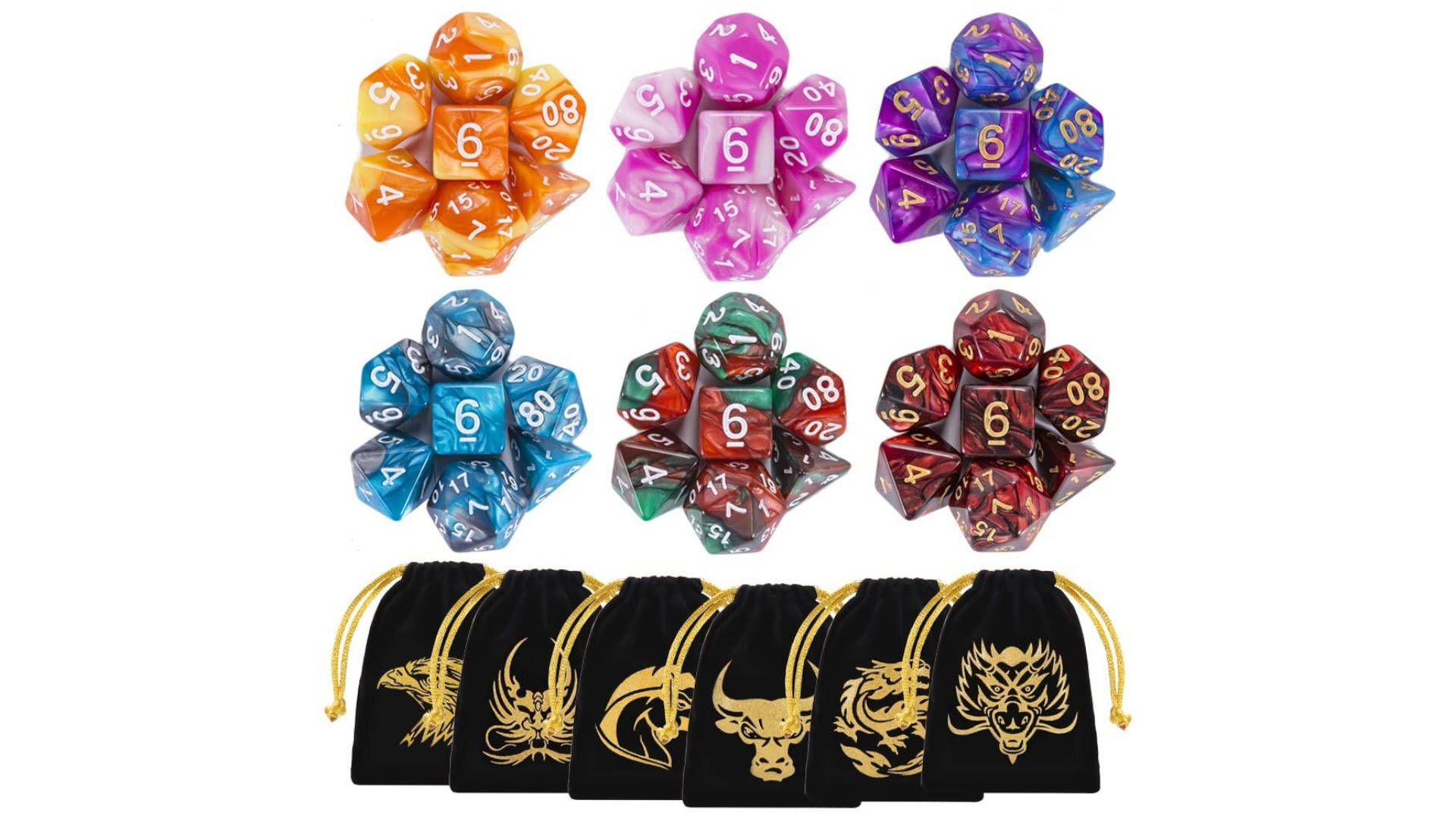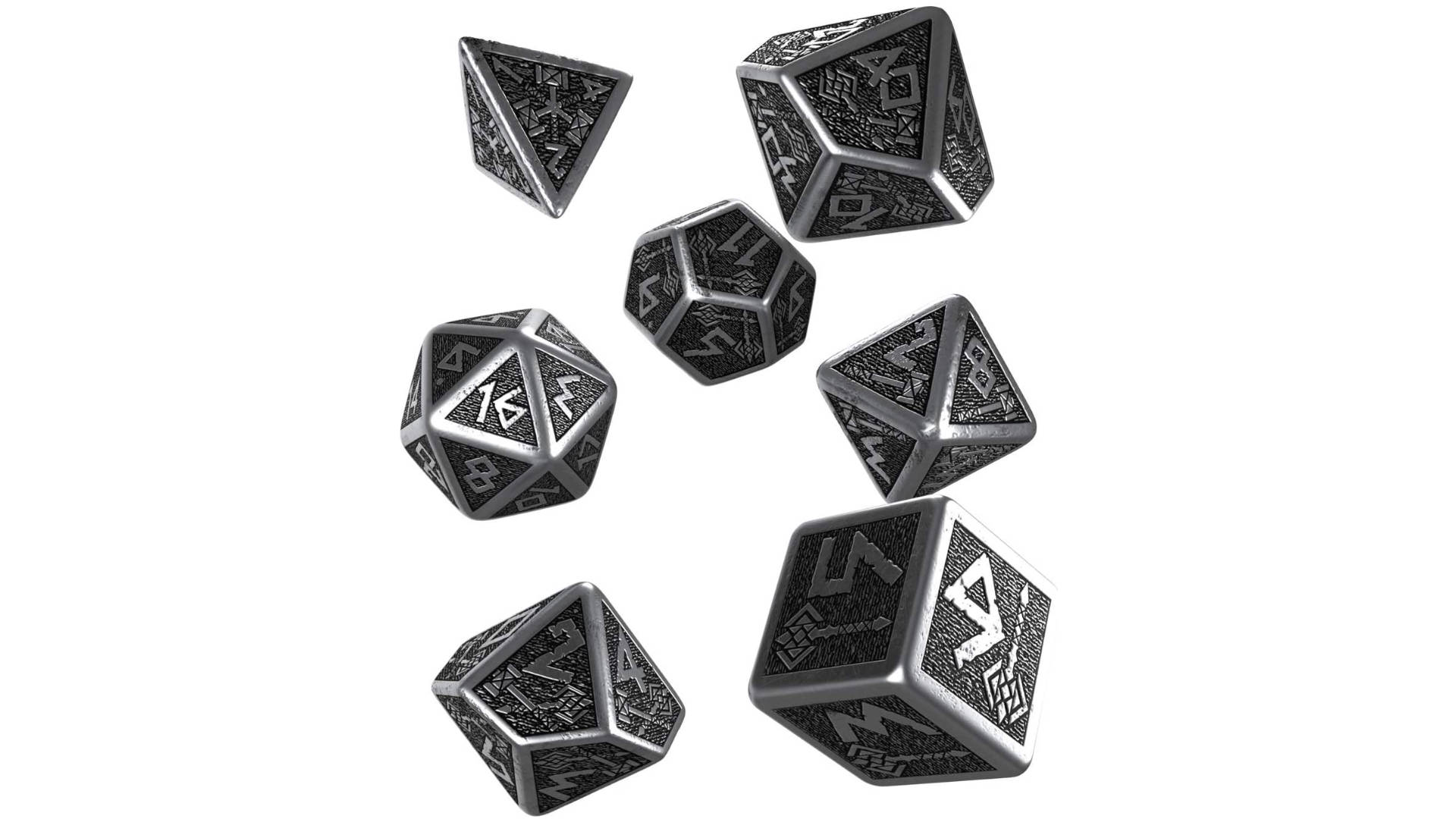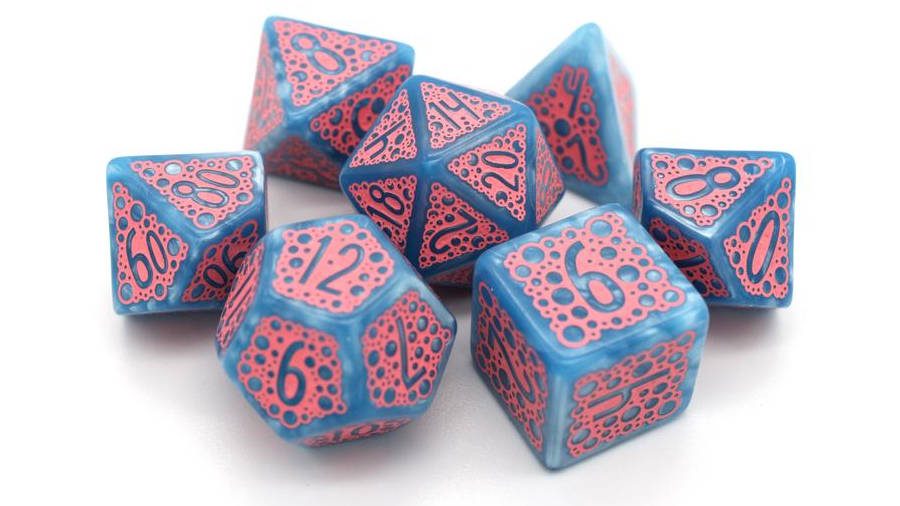Ah, D&D dice. Of all the possible gameplay components, roleplaying accoutrements, and tabletop miniatures you’ll use in a Dungeons and Dragons adventure, there might be nothing more important than dice. For all your free will, and player choice, a single die roll will determine how your actions fare in-game: the success of that daring attack, or the embarrassing failure of an ill-thought remark to an NPC.
For new players taking their first step on the hopeful road of adventure, the thought of rolling anything other than a cube might seem a little odd. Even for hardened players keen to add some flair to their dice rolling, the sheer number of polyhedrons available to buy is seemingly endless. Well, panic ye not, adventurers – we’re here to give a snappy tour through the geometric geography of all things dice-related.
We’ll give a quick rundown of what’s in a D&D dice set, what to consider when choosing dice, our picks of the best sets around, and the options for rolling dice online during remote roleplaying sessions. You’ll be cavorting with translucent octahedrons and cursing your Dungeon Master’s natural 20s in no time.
Let’s start with the basics…
What’s in a D&D dice set?
If you’ve never dealt with anything other than a standard six-sided die, nor felt the plasticky balance of slick polyhedrons slipping lusciously between your fingers, let’s clear one thing up straight away: a basic D&D dice set contains seven dice of six different shapes. Each provides different probabilistic possibilities, and are used to perform varying jobs in your party’s roleplaying.
A basic DnD dice set contains seven dice of six shapes
To get going, you’ll need one of each – a d20, d12, d8, d6, d4, and two d10s. If you’re new to the tabletop and totally confused by that notation, don’t worry. Each number after the letter ‘d’ refers to the number of sides possessed by that dice: a twenty-sided die is called a d20, a twelve-sided die a d12, and so on. So, if your DM commands you to roll a d20, grab that twenty-sided beast and get throwing. Simple stuff.
In a standard set of seven dice, the two d10s are little different from each other. The faces of one will be numbered in single digits (zero to nine), while the other numbered in units of ten (00 to 90). The latter is often referred to as a d%, since it’s used to calculate percentage scores. To do so, roll your d% to determine a tens digit, and the d10 to produce a single digit; add them together to calculate a number between one to 100 and, hey presto, you’ve got yourself a percentage.
If you don’t have a die marked up to 100, you can roll two normal d10s to determine percentage scores, following the same method. Use one of the dice to determine your tens digit (mentally adding an extra zero to its faces), and the other d10 to roll a single digit; add them together as before to get a percentage score.
Hero’s Journey: Our guide to Dungeons and Dragons’ starter set
You might find it useful to have a spare d6 kicking around, too, when rolling for attack damage. For DMs, having an entire second, or third, set of dice is handy when rolling for large groups of NPCs, traps, or worldly happenings. In any case, if you’re ever short of a die, nab an extra from another player – we’re sure they won’t mind.
Occasionally, you might find reference to the elusive d2, and wonder what on earth that means. A d2 isn’t so much a two-sided dice, as it is shorthand for anything able to generate a 50:50 probability outcome. Usual practice is to flip a coin, or roll for an even vs. odd outcome using any die.
How to choose a D&D dice set
For new players picking up their first seven-piece set, as well as old dungeon hands in the need of a fresh makeover, choosing which D&D dice set to grab can be a tad difficult. With so many makers of dice offering a veritable abundance of colourful options, you can’t go far wrong, but it’s worth giving thought to a few factors when making your decision.
UNEVEN, UNWEIGHTED, OR ASYMMETRICAL DICE WON’T ROLL TRUE ON THE TABLEtop
First up, pay attention to the balance and fairness of your dice. You’ll be using them to simulate random chance, so it’s important they have (roughly) equal probability across their faces. A d20 that keeps landing on a five won’t be much fun for you or your party. Give them a roll and see if any badly favour a particular number, or have a tendency to never face one side. If they feel uneven, unweighted, or asymmetrical in your fingers, they won’t roll true.
For the most part, you can assume this as given. Any mass-produced, machine-cut dice are likely to be as fair as you’ll need. Even when buying from independent retailers, chances are they’re using the same manufacturing processes as everyone else. Check for visual red flags, but don’t spend too long looking.
Equally important is the readability of your dice. Grab a set with numbers that blend into their background, and you’ll spend most of your time squinting to read your die, or cursing yourself that you didn’t buy a more conspicuous set. Look for dice with a high-contrast paint job, where the numbers pop off their faces, allowing you and your party to read them at a glance.
Roll20: This is how to play RPG games online
You might be drawn to a particular material of dice: metal, plastic, wood, or stone. For the most part, their differences are purely aesthetic. It can look, and sound, cool to roll a clunky metal d8, or whizz a stone d20 across the table, but their differences are negligible.
Wood dice are light, while metal dice feel weighty, look shiny, and come with a sense of self-conceited permanence (metal dice are the egoistic bards of dice). One thing to note, though: if you are taken by metal dice, be sure to roll them on a tray or mat, unless you want dings, dents, and scratches to appear all over your DM’s table.
Consider the context in which the dice will be used
That brings us to possibly the most important element of D&D dice: style. Have a favourite colour? You can be damn sure there’s dice available in it. Fancy luminescent dice with sparkly highlights? That too. Dice themed to a particular historical or imagined mythology? You bet. Dice come in all flavours and varieties, and you can be sure that whatever you’re currently imagining has been replicated in some form already, somewhere on the internet (probably Kickstarter).
You might also consider the context in which the dice will be used, and try matching their visual flavour to the character you’re roleplaying. It might seem out of place for a chaotic wizard obsessed with arcane necromantic secrets to be rolling ostentatious yellow dice with cutesy rabbit pictures on the side (unless cutesy rabbits happen to be precisely what your Necromancer is into – we don’t judge). Not fussed? More power to you. But if you’re wanting to maximise your party’s roleplaying surroundings, think about what would suit the mood.
The best D&D dice
 Buy Now
Buy Now
Best cheap dice
If you’re looking for a batch of inexpensive dice for your whole party, you can’t go wrong with these plastic polyhedral dice. Their swirly multi-coloured design is snazzy, and six full sets are likely to provide enough dice for your whole party, especially for beginner characters. The included dice bags make for easy storage (if you don’t mind the irrelevant, generic fantasy symbols on their sides), and the large, white typeface makes the dice easy to read at a glance. Simple and effective.
 Buy Now
Buy NowBest metal dice
Metal dice have a certain gravitas. Hearing them clunk on the table makes your decisions feel that much weightier. As you’d expect, there’s a whole heap of options out there, but we think this set of metal dice is a lovely all-rounder choice. Coming in gold, silver, or brass colours, each with big, bold numbering, and a handy storage tin, they’re weighty but not gaudy.
Class list: Check out our D&D classes guide
If you’re looking for something a little more visually stimulating, these dwarven-themed metal dice have a hearty runic motif, and come from Q Workshop, which has long been popular in the hobby space for their affordable, quality dice sets.
 Buy Now
Buy NowBest precision dice
Dice balance in is a bit of a contested topic. No die will be completely probabilistically fair, and most cheaper options will be sufficient. If you find a bad apple, swap it out. But if you want to be doubly sure that your dice rolls aren’t overly skewed, Chessex is a well-known, reliable brand that is likely to meet your needs.
We think their Gemini dice are a lovely option. Meaty and multicoloured, they remain accurate and reliable when rolled. There’s also a range of colours to choose from, so find whichever most appeals to your eye.
 Buy Now
Buy NowBest thematic dice
When you want to really embrace your roleplaying, get a set of thematic dice to put you in the mood. This might be as simple as finding an appropriate colour scheme, while other dice sets will ape particular art styles or imagery. We think Q Workshop has a fabulous selection of thematic dice that are as snazzy as they are affordable.
Pen-and-paper: These are the best tabletop RPGs
Check out their range of Celtic dice for elegant knotwork, their forest range with leaf motifs, elvish dice with a fancy script, or runic dice covered in Norse-esque writing. They also produce a slew of game-specific dice sets, like those for Pathfinder or Call of Cthulhu, for those with strong brand loyalty.
 Buy Now
Buy NowBest job lot of dice
If using a hodgepodge of unmatching dice of various colours and sizes doesn’t faze you, Chessex’s Pound-O-Dice has long been a go-to assortment of random dice for D&D players. You’ll find around 100 dice of varying styles and colours, spanning all required shapes.
Including marbled, opaque, translucent, and speckled designs, it provides a handy way of building lots of dice sets at once, supplementing sets that have lost a die or two, or adding extra dice to your rolls when needed. Bear in mind they’re all factory rejects, meaning the dice didn’t meet sufficient quality standards to make it to the shop floor, or were leftover from sets that didn’t sell. It’s not uncommon to find air bubbles or other imperfections, so keep an eye out for any undue probability curves.
 Buy Now
Buy Now
Best dice storage solution
So you’ve bought a whole load of dice, but where do you keep them when you’re not attempting to charm a nymph or land a killing blow on a pesky kobold? Your easiest solution is to bung them all in a drawstring bag. The default for many D&D players remains the Crown Royal bag, used to package the titular whisky.
Alt-D&D: Check out our Pathfinder classes guide
Small, elegant, and with a scent of class about them, they’re useful, but any pouch should do. If you’re feeling particularly ambitious in your dice collecting, you could buy a large, multi-compartment bag, such as this, but only if you know you’ll be hoarding hundreds of dice at a time.
Other homemade solutions include card boxes, tackle boxes, and pencil cases.
Using D&D dice online
Sometimes, physical dice won’t cut it. When roleplaying remotely, using dice on the tabletop sucks out all the fun. When you can’t all see the roll, there’s no tension in the build-up, no sudden release following a favourable score. And removing all rolling from the eyes of the DM runs the risk of any unscrupulous player altering the results of lady luck in their favour.
Fortunately, there’s many easy-to-use, sleek, and free ways of rolling virtual dice online.
There’s a formidable mountain of browser-based dice rollers
If you’re using Roll20, its in-built Quick Roll button lets you select the relevant sided dice, and add an appropriate modifier, for an instant score. Alternatively, if D&D Beyond is your go-to character-tracker, you can tap any rollable ability on your character sheet and have a relevant die spawn instantly. The app will add modifiers and crunch the numbers automatically. You can even get multiple different sets of animated special dice on there these days.
There’s also a formidable mountain of browser-based dice rollers, if your online sessions amount to little more than a zoom call. This online dice roller from Wizards might look like the roleplaying equivalent of Windows ME, but it’s super simple and cuts out all the chaff. Otherwise, this online roller is a little easier on the eyes, while Rolz lets you create chat rooms if you’d like to add some community spirit to your rolling.
Source: Wargamer












